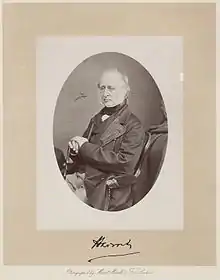The Earl of Harrowby | |
|---|---|
 | |
| Chancellor of the Duchy of Lancaster | |
| In office 31 March 1855 – 7 December 1855 | |
| Monarch | Victoria |
| Prime Minister | The Viscount Palmerston |
| Preceded by | The Earl Granville |
| Succeeded by | Matthew Talbot Baines |
| Lord Privy Seal | |
| In office 7 December 1855 – 3 February 1858 | |
| Monarch | Victoria |
| Prime Minister | The Viscount Palmerston |
| Preceded by | The Duke of Argyll |
| Succeeded by | The Marquess of Clanricarde |
| Personal details | |
| Born | 19 May 1798 London, England |
| Died | 19 November 1882 (aged 84) Sandon Hall, Sandon, Staffordshire, England |
| Spouse |
Lady Frances Stuart
(m. 1823; died 1859) |
| Children | Dudley Ryder, 3rd Earl of Harrowby Henry Ryder, 4th Earl of Harrowby |
| Parent(s) | Dudley Ryder, 1st Earl of Harrowby Lady Susan Leveson-Gower |
| Alma mater | Christ Church, Oxford |
Dudley Ryder, 2nd Earl of Harrowby, KG, PC, FRS (19 May 1798 – 19 November 1882), styled Viscount Sandon between 1809 and 1847, was a British politician. He held office under Lord Palmerston as Chancellor of the Duchy of Lancaster in 1855 and as Lord Privy Seal between 1855 and 1858.
Background and education
Harrowby was born in London, the son of Dudley Ryder, 1st Earl of Harrowby and his wife Lady Susanna Leveson-Gower (1772 - 1838), daughter of Granville Leveson-Gower, 1st Marquess of Stafford. He was educated at Christ Church, Oxford.
He was an officer of the Staffordshire Yeomanry, being commissioned as a lieutenant in the Stafford Troop on 20 December 1819 and being promoted to captain on 26 March 1826.[1] He resigned his commission in March 1831.[2]
Political career
Harrowby was elected Member of Parliament for Tiverton in 1819, a seat he held until 1831[3] before switching to represent Liverpool until 1847.[4] He served as a Lord of the Admiralty in 1827[5] and as Secretary to the Board of Control under Lord Grey between 1830 and 1831. He had a London home in Grosvenor Square.[6]
In 1847, he became Earl of Harrowby and took up a seat in the House of Lords. He remained out of office for a long time, but in 1855, eight years after he had succeeded his father as Earl of Harrowby, he was appointed Chancellor of the Duchy of Lancaster[7] by Lord Palmerston, becoming a Privy Counsellor at the same time.[8] In a few months he was transferred to the office of Lord Privy Seal, a position which he resigned in 1858.
He was made a Knight of the Garter in 1859.[9] Harrowby was also three times President of the Royal Statistical Society (1840–1842, 1849–1851, 1855–1857), chairman of the Maynooth commission and a member of other important royal commissions. He was regarded as among the most stalwart and prominent defenders of the Church of England.[5]
Marriage and children
%252C_by_Alfred_Edward_Chalon.jpg.webp)
Lord Harrowby married Lady Frances Stuart, daughter of John Stuart, 1st Marquess of Bute, on 15 September 1823. They had two sons:[10]
- Dudley Francis Stuart Ryder, 3rd Earl of Harrowby (16 January 1831 - 26 March 1900)
- Henry Dudley Ryder, 4th Earl of Harrowby (3 May 1836 - 11 December 1900)
Death
Lady Harrowby died in March 1859. Lord Harrowby remained a widower until his death at Sandon Hall on 19 November 1882, aged 84. He was succeeded in the earldom and other titles by his elder son, Dudley.
References
- ↑ Capt P.C.G. Webster, The Records of the Queen's Own Royal Regiment of Staffordshire Yeomanry, Lichfield: Lomax, 1870; Appendix.
- ↑ "No. 18787". The London Gazette. 25 March 1831. p. 573.
- ↑ "leighrayment.com House of Commons: Tipperary South to Tyrone West". Archived from the original on 15 July 2018. Retrieved 4 October 2009.
{{cite web}}: CS1 maint: unfit URL (link) - ↑ "leighrayment.com House of Commons: Lichfield and Tamworth to London and Westminster South". Archived from the original on 29 October 2008. Retrieved 4 October 2009.
{{cite web}}: CS1 maint: unfit URL (link) - 1 2 Chisholm, Hugh, ed. (1911). . Encyclopædia Britannica. Vol. 13 (11th ed.). Cambridge University Press. p. 28.
- ↑ "Grosvenor Square: Individual Houses built before 1926 Pages 117-166 Survey of London: Volume 40, the Grosvenor Estate in Mayfair, Part 2 (The Buildings)". British History Online. LCC 1980. Retrieved 5 December 2022.
- ↑ "No. 21688". The London Gazette. 3 April 1855. p. 1334.
- ↑ "No. 21688". The London Gazette. 3 April 1855. p. 1324.
- ↑ "No. 22281". The London Gazette. 1 July 1859. p. 2549.
- ↑ Mosley, Charles, editor. Burke's Peerage, Baronetage & Knightage, 107th edition, 3 volumes. Wilmington, Delaware, U.S.A.: Burke's Peerage (Genealogical Books) Ltd, 2003
External links
- . Dictionary of National Biography. London: Smith, Elder & Co. 1885–1900.
- Hansard 1803–2005: contributions in Parliament by the Earl of Harrowby